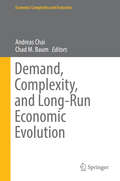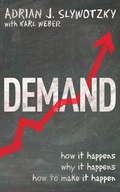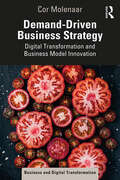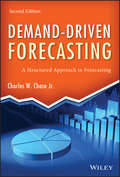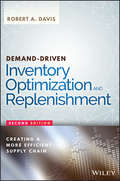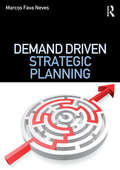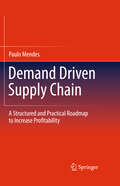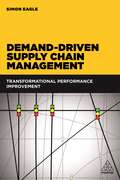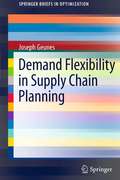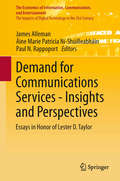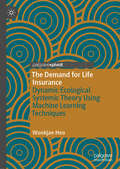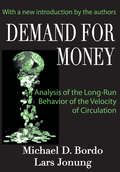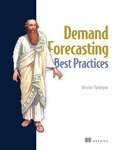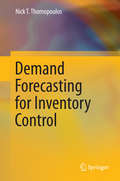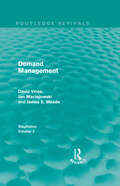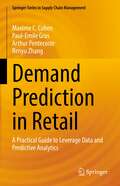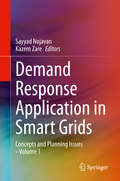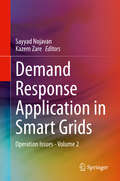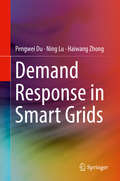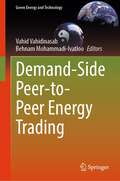- Table View
- List View
Demand, Complexity, and Long-Run Economic Evolution (Economic Complexity and Evolution)
by Andreas Chai Chad M. BaumThe purpose of this contributed volume is to consider how global consumption patterns will develop in the next few decades, and what the consequences of that development will be for the economy, policymakers, and society at large. In the long run, the extent to which economic growth translates into better living conditions strongly depends on how rising affluence and new technologies shape consumer preferences. The ongoing rise in household income in developing countries raises some important questions: Will consumption patterns always continue to expand in the same manner as we have witnessed in the previous two centuries? If not, how might things evolve differently? And what implications would such changes hold for not only our understanding of consumption behavior but also our pursuit of more sustainable societies?
Demand: Creating What People Love Before They Know They Want It
by Karl Weber Adrian Slywotzky Adrian Slywotzky With Karl WebDemand is one of the few economic terms almost everyone knows. Demand drives supply. When demand rises, it stimulates growth - jobs are created, the economy flourishes and society thrives. So goes the theory. It sounds simple, yet almost no one really understands demand, including the business owners, company leaders and policy makers who try to stimulate and satisfy it. DEMAND is a book with breakout general non-fiction potential which searches for clues as to where demand really comes from, and why, and how we might control it.
Demand-Driven Business Strategy: Digital Transformation and Business Model Innovation (Business and Digital Transformation)
by Cor MolenaarDemand-Driven Business Strategy explains the ways of transforming business models from supply driven to demand driven through digital technologies and big data analytics. The book covers important topics such as digital leadership, the role of artificial intelligence, and platform firms and their role in business model transformation. Students are walked through the nature of supply- and demand-driven models and how organizations transform from one to the other. Theoretical insights are combined with real-world application through global case studies and examples from Amazon, Google, Uber, Volvo and Picnic. Chapter objectives and summaries provide consistent structure and aid learning, whilst reflective questions encourage further thought and discussion. Comprehensive and practical, this is an essential text for advanced undergraduate and postgraduate students studying strategic management, marketing, business innovation, consumer behavior, digital transformation and entrepreneurship.
Demand-Driven Forecasting
by Charles W. Chase Jr.Praise for Demand-Driven ForecastingA Structured Approach to Forecasting"There are authors of advanced forecasting books who take an academic approach to explaining forecast modeling that focuses on the construction of arcane algorithms and mathematical proof that are not very useful for forecasting practitioners. Then, there are other authors who take a general approach to explaining demand planning, but gloss over technical content required of modern forecasters. Neither of these approaches is well-suited for helping business forecasters critically identify the best demand data sources, effectively apply appropriate statistical forecasting methods, and properly design efficient demand planning processes. In Demand-Driven Forecasting, Chase fills this void in the literature and provides the reader with concise explanations for advanced statistical methods and credible business advice for improving ways to predict demand for products and services. Whether you are an experienced professional forecasting manager, or a novice forecast analyst, you will find this book a valuable resource for your professional development."--Daniel Kiely, Senior Manager, Epidemiology, Forecasting & Analytics, Celgene Corporation"Charlie Chase has given forecasters a clear, responsible approach for ending the timeless tug of war between the need for 'forecast rigor' and the call for greater inclusion of 'client judgment.' By advancing the use of 'domain knowledge' and hypothesis testing to enrich base-case forecasts, he has empowered professional forecasters to step up and impact their companies' business results favorably and profoundly, all the while enhancing the organizational stature of forecasters broadly."--Bob Woodard, Vice President, Global Consumer and Customer Insights, Campbell Soup Company
Demand-Driven Inventory Optimization and Replenishment
by Robert A. DavisUse demand driven optimized inventory and replenishment to overcome your supply chain weaknesses, and deliver business-maximizing results Reviewing the fundamentals of inventory optimization so that you can attain a demand-driven supply, Demand-Driven Inventory Optimization and Replenishment provides a business look at why present inventory systems sub-optimize the supply chain and faulty replenishment processes lead to wasted time and effort. Straightforward and clearly written, this book allows readers to come away with a good understanding of why optimized inventory and replenishment helps overcome in-system weaknesses and deliver results. Discusses how multi-echelon inventory optimization and replenishment enables installed systems to go from a sequential, "islands of efficiency" approach to a systematic distribution system working as a complete network Provides case studies throughout Reveals how optimized inventory and replenishment delivers results across industry verticals With a historical view of the three major supply chain efforts of the last thirty years, this book discusses mathematical shortcuts set up in the transitional and supply chain management systems that make it very difficult for companies to attain supply chain excellence.
Demand Driven Strategic Planning
by Marcos Fava NevesThis book offers students and practitioners alike an integrated approach to strategic planning for companies. Marcos Fava Neves presents a new and unique perspective on this critical topic based on three main points: strongly demand-driven decisions that bridge the gap between long- and short-term strategy; a vision of a company as an integrated network, full of relationships that deserve consideration during the planning process; and the introduction of ‘collective-action’ thinking, which raises the prospect for cooperation between competitors. With this clear, comprehensive framework for strategic planning, companies can be sure to navigate today’s complex environment and enhance their prospects of success.
Demand Driven Supply Chain: A Structured and Practical Roadmap to Increase Profitability
by Paulo MendesThis book aims to identify and describe the practical key components of demand driven supply chains, and based on these components, develops a structured and integrated assessment framework that companies can use to assess their current and desired future supply chain states in light of the Demand Driven Supply Chain (DDSC) concepts. Another contribution of the book is the structured framework developed to design a supply chain strategy, which will consider the DDSC assessment results as one of the key inputs, and will support the implementation of the opportunities identified during the assessment. The framework presented in this book was applied in different supply chain operations of a global CPG company to validate the methodology and formalize an action plan to allow these operations move towards a DDSC. Results show clear opportunities to improve supply chain operation and become more demand driven.
Demand-Driven Supply Chain Management: Transformational Performance Improvement
by Simon EagleMany manufacturing and distribution companies are moving from the traditional 'forecast push MRP' to demand-driven supply chain management (SCM). Demand-driven SCM is an 'end-to-end' supply chain planning and replenishment process that enables companies to achieve their planned service levels from up to half the average level of inventory and requiring significantly less throughput capacity - irrespective of the level of demand volatility or lead-time length. Demand-Driven Supply Chain Management is the go-to source for industry supply chain/operations executives and students. It describes, in a readable but rigorous manner, the 'what, how and why' of the demand-driven SCM process. The key themes in the book are: what is demand-driven? why is demand-driven so effective? how to operate a demand-driven supply chain? and how to adopt the demand-driven process in your company? The book has been written in such a way that it doesn't require reading from cover to cover. Readers can quickly grasp the essential concepts from one of numerous self-contained sections that present the book's key concepts from different perspectives.
Demand Flexibility in Supply Chain Planning
by Joseph GeunesThis work encapsulates the essential developments in this field into a single resource, as well as to set an agenda for further development in the field. This brief focuses on the demand flexibility in supply chains with fragmented results distributed throughout the literature. These results have strong implications for managing real-world complex operations planning problems. This book exploits dimensions of demand flexibility in supply chains and characterizes the best fit between demand properties and operations capabilities and constraints. The origins and seminal works are traced in integrated demand and operations planning and an in-depth documentation is provided for the current state of the art. Systems with inherent costs and constraints that must respond to some set of demands at a minimum cost are examined. Crucial unanswered questions are explored and the high-value research directions are highlighted for both practice and for the development of new and interesting optimization models and algorithms.
Demand for Communications Services - Insights and Perspectives
by James Alleman Áine Marie Patricia Ní-Shúilleabháin Paul N. RappoportThis volume grew out of a conference organized by James Alleman and Paul Rappoport, conducted on October 10, 2011 in Jackson Hole, Wyoming, in honor of the work of Lester D. Taylor, whose pioneering work in demand and market analysis has had profound implications on research across a wide spectrum of industries In his Prologue, Eli M. Noam notes that demand analysis in the information sector must recognize the "public good" characteristics of media products and networks, while taking into account the effects of interdependent user behavior; the strong cross-elasticities in a market; as well as the phenomenon of supply creating its own demand The second Prologue, by Timothy Tardiff and Daniel Levy, focuses more specifically on Taylor's body of work, in particular its practical applications and usefulness in analyses of, and practices within, the Information and Communications Technology (ICT) sector (known in Europe and elsewhere as the Telecommunications, Media, and Technology (TMT) sector) The remainder of the book is organized into four parts: Advances in Theory; Empirical Applications; Evidence-Based Policy Applications; and a final Conclusion The book closes with an Appendix by Sharon Levin and Stanford Levin detailing Taylor's contributions using bibliometrics. Not only featuring chapters from distinguished scholars in economics, applied sciences, and technology, this volume includes two contributions directly from Lester Taylor, providing unique insight into economics from a lifetime in the field. "What a worthy book! Every applied researcher in communications encounters Lester Taylor's work. Many empirical exercises in communications can trace their roots to Taylor's pioneering research and his thoughtful leadership. This book assembles an impressive set of contributors and contributions to honor Taylor. No surprise, the collection extends far and wide into many of the core topics of communications and media markets. The emphasis is where it should be-on important and novel research questions informed by useful data --Shane Greenstein, Professor of Management and Strategy, Kellogg School of Management, Northwestern University "For more than 40 years, Lester Taylor has been a leader in the application of consumer modeling, econometric techniques and microeconomic data to understand residential and business user behavior in telecommunications markets. During that time, he inspired a cadre of students and colleagues who applied this potent combination to address critical corporate and regulatory issues arising in the telecommunications sector. This volume collects the recent product of many of these same researchers and several other devotees who go beyond empirical analysis of fixed line service by extending Prof. Taylor's approach to the next wave of services and technologies. These contributions, including two new papers by Prof. Taylor, offer an opportunity for the next generation to learn from his work as it grapples with the pressing issues of consumer demand in the rapidly evolving digital economy. " -- Glenn Woroch, Adjunct Professor of Economics, University of California, Berkeley
The Demand for Health: A Theoretical and Empirical Investigation (Occasional Papers #No. 119)
by Michael GrossmanA seminal work in health economics first published in 1972, Michael Grossman's The Demand for Health introduced a new theoretical model for determining the health status of the population. His work uniquely synthesized economic and public health knowledge and has catalyzed a vastly influential body of health economics literature. It is well past time to bring this important work back into print. Grossman bases his approach on Gary S. Becker's household production function model and his theory of investment in human capital. Consumers demand health, which can include illness-free days in a given year or life expectancy, and then produce it through the input of medical care services, diet, other market goods and services, and time. Grossman also treats health and knowledge as equal parts of the durable stock of human capital. Consumers therefore have an incentive to invest in health to increase their earnings in the future. From here, Grossman examines complementarities between health capital and other forms of human capital, the most important of which is knowledge capital earned through schooling and its effect on the efficiency of production. He concludes that the rate of return on investing in health by increasing education may exceed the rate of return on investing in health through greater medical care. Higher income may not lead to better health outcomes, as wealth enables the consumption of goods and services with adverse health effects. These are some of the major revelations of Grossman's model, findings that have great relevance as we struggle to understand the links between poverty, education, structural disadvantages, and health.
The Demand for Imports and Exports in the World Economy (Routledge Revivals)
by W. Charles Sawyer Richard L. SprinkleFirst published in 1999, this volume responds to one of the more important issues in applied international economics: the extent to which trade flows adjust to changes in income, relative prices and exchange rates. This work surveys the literature on empirical estimation of the demand for imports and exports for the US. The book is designed to be a reference book for both academic international economists and international trade practitioners in government, international organisations and the private sector.
The Demand for Life Insurance: Dynamic Ecological Systemic Theory Using Machine Learning Techniques
by Wookjae HeoThis book, adopting machine learning techniques for the financial planning field, explores the demand for life insurance as seen in previous literature and both estimates and predicts the demand for the adoption of life insurance using these techniques. Previous studies used diverse perspectives, like actuarial and life span, in order to understand the demand for life insurance, though these approaches have shown inconsistent findings. Employing two theoretical backgrounds—ecological systemic theory and artificial intellectual methodology—this book explores a better estimation and a prediction of the demand for life insurance and will be of interest to academics and students of insurance, financial planning, and risk management.
Demand for Money: An Analysis of the Long-run Behavior of the Velocity of Circulation
by Lars JonungThe income velocity of money-an inverse measure of the demand for money balances-is the ratio of the money value of income to the average money stock that the public (excluding banks) holds in a given period. Why the magnitude of that ratio has changed over time is the subject of Michael D. Bordo and Lars Jonung's classic study, originally published as The Long-Run Behavior of the Velocity of Circulation. Supported by statistical data, econometric estimation techniques, and meticulous historical analysis, this work describes, in an international setting, how slow-moving economic, social, and political forces interact with the decisions households and firms make about how much money to hold.Annual time series of velocity for several countries from the late nineteenth century to the late twentieth century display a U-shaped pattern. Existing theories can explain each section of the velocity curve-the falling, flat, and rising parts-but the overall pattern is not consistent with any one theory. Here the authors put forth a comprehensive explanation for this behavior over time. Their theory is largely an extension of the approach of Knut Wicksell, the Swedish economist who stressed the role of substitution between monetary assets. This approach, which emphasizes institutional variables, is incorporated into the arguments for the traditional long-run money demand (velocity) function. Four types of empirical evidence strongly support the authors' theory: econometric studies of the long-run velocity function for several countries; a cross section study of approximately eighty countries in the postwar period; a case study of the Swedish monetization process in the fifty years before World War I; and an examination of the time series properties of velocity.Demand for Money suggests that institutional factors, as opposed to real income, play a greater role in velocity than previously thought. And these institutional factors have a major impact on monetary policy. This is a book that will prove of great value to economists, monetary strategists, and policymakers.
Demand Forecasting Best Practices
by Nicolas VandeputLead your demand planning process to excellence and deliver real value to your supply chain.In Demand Forecasting Best Practices you&’ll learn how to: Lead your team to improve quality while reducing workload Properly define the objectives and granularity of your demand planning Use intelligent KPIs to track accuracy and bias Identify areas for process improvement Help planners and stakeholders add value Determine relevant data to collect and how best to collect it Utilize different statistical and machine learning models An expert demand forecaster can help an organization avoid overproduction, reduce waste, and optimize inventory levels for a real competitive advantage. Demand Forecasting Best Practices teaches you how to become that virtuoso demand forecaster. This one-of-a-kind guide reveals forecasting tools, metrics, models, and stakeholder management techniques for delivering more effective supply chains. Everything you learn has been proven and tested in a live business environment. Discover author Nicolas Vandeput&’s original five step framework for demand planning excellence and learn how to tailor it to your own company&’s needs. Illustrations and real-world examples make each concept easy to understand and easy to follow. You&’ll soon be delivering accurate predictions that are driving major business value. About the Technology An expert demand forecaster can help an organization avoid overproduction, reduce waste, and optimize inventory levels for a real competitive advantage. This book teaches you how to become that virtuoso demand forecaster. About the Book Demand Forecasting Best Practices reveals forecasting tools, metrics, models, and stakeholder management techniques for managing your demand planning process efficiently and effectively. Everything you learn has been proven and tested in a live business environment. Discover author Nicolas Vandeput&’s original five step framework for demand planning excellence and learn how to tailor it to your own company&’s needs. Illustrations and real-world examples make each concept easy to understand and easy to follow. You&’ll soon be delivering accurate predictions that are driving major business value. What's Inside Enhance forecasting quality while reducing team workload Utilize intelligent KPIs to track accuracy and bias Identify process areas for improvement Assist stakeholders in sales, marketing, and finance Optimize statistical and machine learning models About the Reader For demand planners, sales and operations managers, supply chain leaders, and data scientists. About the Author Nicolas Vandeput is a supply chain data scientist, the founder of consultancy company SupChains in 2016, and a teacher at CentraleSupélec, France. Table of Contents: Part 1 - Forecasting demand 1 Demand forecasting excellence 2 Introduction to demand forecasting 3 Capturing unconstrained demand (and not sales) 4 Collaboration: data sharing and planning alignment 5 Forecasting hierarchies 6 How long should the forecasting horizon be? 7 Should we reconcile forecasts to align supply chains? Part 2 - Measuring forecasting quality 8 Forecasting metrics 9 Choosing the best forecasting KPI 10 What is a good forecast error? 11 Measuring forecasting accuracy on a product portfolio Part 3 - Data-driven forecasting process 12 Forecast value added 13 What do you review? ABC XYZ segmentations and other methods Part 4 - Forecasting methods 14 Statistical forecasting 15 Machine learning 16 Judgmental forecasting 17 Now it&’s your turn!
Demand Forecasting for Inventory Control
by Nick T. ThomopoulosThis book describes the methods used to forecast the demands at inventory holding locations. The methods are proven, practical and doable for most applications, and pertain to demand patterns that are horizontal, trending, seasonal, promotion and multi-sku. The forecasting methods include regression, moving averages, discounting, smoothing, two-stage forecasts, dampening forecasts, advance demand forecasts, initial forecasts, all time forecasts, top-down, bottom-up, raw and integer forecasts, Also described are demand history, demand profile, forecast error, coefficient of variation, forecast sensitivity and filtering outliers. The book shows how the forecasts with the standard normal, partial normal and truncated normal distributions are used to generate the safety stock for the availability and the percent fill customer service methods. The material presents topics that people want and should know in the work place. The presentation is easy to read for students and practitioners; there is little need to delve into difficult mathematical relationships, and numerical examples are presented throughout to guide the reader on applications. Practitioners will be able to apply the methods learned to the systems in their locations, and the typical worker will want the book on their bookshelf for reference. The potential market is vast. It includes everyone in professional organizations like APICS, DSI and INFORMS; MBA graduates, people in industry, and students in management science, business and industrial engineering.
Demand Management: Stagflation - Volume 2 (Routledge Revivals: Stagflation #Vol. 02)
by David A Vines J. M. Maciejowski J. E. MeadeFirst published in 1983, this is the second of two volumes on the causes and cure of stagflation – that combination of mass unemployment and rapid inflation that is currently afflicting the mixed economies of the industrially developed world. The authors deplore the unemployment due to the failure of governments to adopt Keynesian measures for the expansion of economic activity, but recognise that in present conditions such measures would lead to an unacceptable and explosive inflation of money wages and prices. They therefore advocate a dual strategy of financial policies for a steady expansion of total money incomes combined with individual wage rates set at levels to promote employment. The book is of importance for all those concerned with macroeconomic theory and policy. The description of the meaning of a New Keynesian policy and of the arguments for it have been written in a way which should be intelligible to policy-makers and students, and not only to economists with technical training. Professional macroeconomists will be interested not only in these sections but also in the fully specified macroeconomic model used to analyse New Keynesian policies in economic terms and to carry out a counterfactual re-running of history. In addition, the unusually detailed exposition of the application of control techniques to a difficult multivariable control problem also makes the book of interest to control engineers who wish to acquaint themselves with recent generalisations of classical frequency response methods.
Demand Media
by John Deighton Leora KornfeldGoogle search had helped Demand Media grow to be a $1.9 billion online publisher. Then, social media and smartphone apps began to change the way people navigated the Internet. How should Demand Media respond? The business ran on a radically new model in which a stable of 10,000 freelance contributors supplied content, the Internet's search engines brought it 75 million readers each month, and advertising generated revenue. It took the guesswork out of content production, with algorithms that indicated which topics were being searched and created content accordingly. Demand treated its 5,000 online articles published per day as an investment, not a cost, a reversal of the traditional media model. In addition to being able to infer consumers' interests with its algorithm, the company had a formula for estimating the lifetime value of each piece of content. As the business models of print and broadcast media declined, Demand had figured out how to leverage digital and social media tools to bring down the costs of creating content and to find an audience. In spring 2011, executives at the five-year-old company were pleased with the company's billion dollar IPO, the biggest Internet IPO since Google's, but changes in consumer behavior on the Internet were obliging a review of the model.
Demand Prediction in Retail: A Practical Guide to Leverage Data and Predictive Analytics (Springer Series in Supply Chain Management #14)
by Maxime C. Cohen Paul-Emile Gras Arthur Pentecoste Renyu ZhangFrom data collection to evaluation and visualization of prediction results, this book provides a comprehensive overview of the process of predicting demand for retailers. Each step is illustrated with the relevant code and implementation details to demystify how historical data can be leveraged to predict future demand. The tools and methods presented can be applied to most retail settings, both online and brick-and-mortar, such as fashion, electronics, groceries, and furniture. This book is intended to help students in business analytics and data scientists better master how to leverage data for predicting demand in retail applications. It can also be used as a guide for supply chain practitioners who are interested in predicting demand. It enables readers to understand how to leverage data to predict future demand, how to clean and pre-process the data to make it suitable for predictive analytics, what the common caveats are in terms of implementation and how to assess prediction accuracy.
Demand Response Application in Smart Grids: Concepts and Planning Issues - Volume 1
by Sayyad Nojavan Kazem ZareThis book analyzes the economic and technical effects of demand response programs in smart grids. A variety of operational and financial benefits are offered by demand response programs (DRPs) for load-serving entities, grid operators, and electricity consumers. The most notable advantages of DRPs are presented in this book, including decreased electricity prices, risk management, market power mitigation, and flexibility of market operations. In-depth chapters discuss the integration of demand response programs for the planning and operation of smart grids and explore the uncertainties of market prices, renewable resources and intermittent load management, making this a useful reference for a variety of different organizations and players in the electricity market, such as reliability organizations, distribution companies, transmission companies, and electric end-users.
Demand Response Application in Smart Grids: Operation Issues - Volume 2
by Sayyad Nojavan Kazem ZareThis book analyzes issues surrounding the efficient integration of demand response programs (DRPs) on operation problems in smart grids. The benefits offered by demand response programs (DRPs) for load-serving entities, grid operators, and electricity consumers are explained, including decreased electricity prices and risk management. In-depth chapters discuss the flexibility of market operations, market power mitigation, and environmental benefits—making this a must-have reference for engineers and related practicing professionals working for organizations in the electricity market, including reliability organizations, distribution companies, transmission companies, and electric end-users.
Demand Response in Smart Grids
by Pengwei Du Ning Lu Haiwang ZhongThis book is the first of its kind to comprehensively describe the principles of demand response. This allows consumers to play a significant role in the operation of the electric grid by reducing or shifting their electricity usage in response to the grid reliability need, time-based rates or other forms of financial incentives. The main contents of the book include modeling of demand response resources, incentive design, scheduling and dispatch algorithms, and impacts on grid operation and planning. Through case studies and illustrative examples, the authors highlight and compare the advantages, disadvantages and benefits that demand response can have on grid operations and electricity market efficiency.First book of its kind to introduce the principles of demand response;Combines theory with real-world applications useful for both professionals and academic researchers;Covers demand response in the context of power system applications.
Demand-side Flexibility in Smart Grid (SpringerBriefs in Applied Sciences and Technology)
by Roya Ahmadiahangar Argo Rosin Ivo Palu Aydin AziziThis book highlights recent advances in the identification, prediction and exploitation of demand side (DS) flexibility and investigates new methods of predicting DS flexibility at various different power system (PS) levels. Renewable energy sources (RES) are characterized by volatile, partially unpredictable and mostly non-dispatchable generation. The main challenge in terms of integrating RES into power systems is their intermittency, which negatively affects the power balance. Addressing this challenge requires an increase in the available PS flexibility, which in turn requires accurate estimation of the available flexibility on the DS and aggregation solutions at the system level. This book discusses these issues and presents solutions for effectively tackling them.
Demand-Side Peer-to-Peer Energy Trading (Green Energy and Technology)
by Vahid Vahidinasab Behnam Mohammadi-IvatlooDemand-Side Peer-to-Peer Energy Trading provides a comprehensive study of the latest developments in technology, protocols, implementation, and application of peer-to-peer and transactive energy concepts in energy systems and their role in worldwide energy evolution and decarbonization efforts. It presents practical aspects and approaches with evidence from applications to real-world energy systems through in-depth technical discussions, use cases, and examples. This multidisciplinary reference is suitable for researchers and industry stakeholders who focus on the field of energy systems and energy economics, as well as researchers and developers from different branches of engineering, energy, computer sciences, data, economic, and operation research fields.
Demand Spillovers and the Collapse of Trade in the Global Recession
by Rudolfs Bems Robert C. Johnson Kei-Mu YiA report from the International Monetary Fund.
